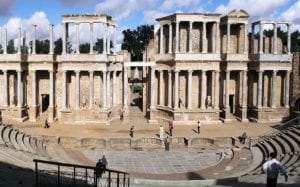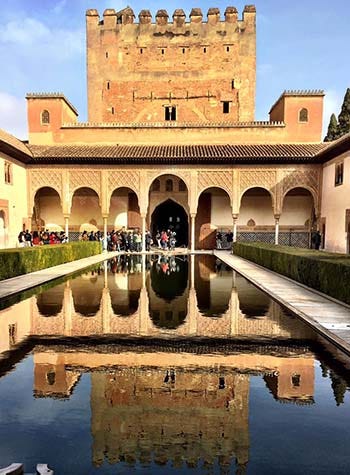Spain is much more than paella and sangria
This country has more facets than beaches, booze, and bulls.
Many American travelers have preconceived notions about what they will find when traveling in Europe. These expectations are often self-fulfilling, as travelers plan to explore what they expect to see.
In Italy, they look for churches, spaghetti, and sexy men (or women, as the case may be). Germany expects cuckoo clocks, men in lederhosen, beer gardens, and fast cars. In France, it's wine, women's fashion, and gourmet food. And in Spain, the quest is almost always for flamenco, bullfights, and beaches.
There is truth to many of these stereotypes, though the lederhosen are hard to find these days. But planning a visit to any country based on preconceptions risks losing the spirit of discovery. Many tourists end up experiencing a vacation on a movie set created just for them rather than engaging with the locals, who can help them enjoy the natural world surrounding the made-for-tourist images.
While every country has surprising sides to its sights and culture, Spain stands out as one of the more astonishing. For years, travel writers have focused on the extravagance of Spain's festivals, such as the elegant April Fair in Seville or the raucous Running of the Bulls in Pamplona. Similarly, writers since Hemingway fixate on bullfights, and every travel agency in the United States and Europe displays posters and brochures selling Spain's sandy beaches. But there's much more to Spain than that.
Spain can surprise even seasoned travelers (including me, who have been traveling to Spain for 40 years). The cultures of the Roman Empire, the medieval Arabs, and the Celtic world are still wonderfully evident in Spain — if you look. The government has spent millions restoring crumbling monasteries and castles to create lodging for visitors. The mountains have snowcapped peaks within sight of cities where the temperature can register 90 degrees. And the restaurants offer much more than paella and sangria.
Roman Spain
Among the most surprising sights in Spain are the impressive ruins left by the Romans. The Iberian Peninsula was one of the essential parts of the Roman Empire. Three of the most influential Roman emperors, Trajan, Hadrian, Marcus Aurelius, and the philosopher Seneca, came from Spain. The Roman legacy is seen everywhere across the countryside, with hillsides covered with vineyards and craggy olive trees introduced here as the empire spread.
The Romans left more than agriculture. Their buildings in the provincial capital of Merida are among the best-preserved Roman ruins in the Mediterranean; in fact, the ancient theater still hosts performances during the summer. The Roman bridge in Salamanca now carries modern traffic. In Tarragona, just south of Barcelona, a well-preserved Roman theater is only steps from the beach. In La Coruña, in the northwest corner of Spain, the only remaining Roman lighthouse in the world, the Tower of Hercules, still stands beaming over the harbor entrance. And in Segovia, one of the most impressive aqueducts in the world — a span of 120 arches — soars almost 100 feet above the main town square.
Arab Spain
The medieval Arabs, who formed one of the most advanced and enlightened civilizations in the post-classical world, settled in Spain after the decline of the Roman Empire. The Alhambra in Grenada stands as one of the most sensuous palaces in Europe. The intricate detail of its decorations and the ingenuity of its water systems and gardens are extraordinary. In Cordoba, the evocative, repetitive arches of the mosque that surrounds the cathedral are almost mesmerizing.
Other buildings and castles built by the Arabs pepper the Spanish countryside. Not just buildings but a pervasive Islamic influence intertwines the region's art, crafts, dances, and gastronomy. Every discovery of a tiling technique, geometric pattern on a church column, or a tapa such as dates wrapped in bacon harks back to this Arab influence.
Celtic Spain
The Celts also left their mark on Spain. The region that bears its cultural mark is Galicia, the far northwest corner of the country. The Celtic influence is not displayed in monuments and stone but music and dance. Here the local music is played on bagpipes and flutes, and the dances resemble what we know as an Irish jig. It is not unusual to find Spaniards in Galicia with red hair and Nordic features.
Mountain Spain
Most tourists' vision of Spain is endless beaches and wide-open plains. However, the peninsula is relatively mountainous. The Pyrenees, which form the northern border with France, are generally overlooked by tourists, but the Spanish love these mountains. The small villages are picture-perfect, packed with whitewashed buildings with rough stones set in the corners and brightly colored windows and doors.
One Pyrenean valley, in particular, Val d'Aran, has remained a bit of a Shangri-La, isolated from Spain by rugged mountains but still annexed politically. This isolation has allowed for the development of a different language. In the past, the valley governed itself in a very socialistic manner, with the citizens sharing grazing land and pastures. The cuisine developed in this hidden valley is a brilliant combination of Spanish and French cooking that gives rise to such meals as Basque fish or lamb chops followed by chocolate soufflé.
Parador hotels
This isn't news to veteran Spain travelers. Still, new travelers to Spain should know that the government has created an astounding system of Parador hotels, either set in spectacular locations or built into restored monasteries, palaces and castles. These hotels are dramatic and not overly expensive. How often can you say you slept in a castle, a palace, or a convent? Some of my favorites are the Paradors in Siguenza (just north of Madrid, photo on the right), Hondarribia (near San Sebastian on the French border), Alarcon (in La Mancha), Santa Catalina (overlooking Jaen in the southeast), and Zamora (near the Portuguese border).
More than paella and plonk
Spanish winemaking and cuisine have come a long way over the past dozen years. Some food critics are beginning to claim that Spanish cooking is at the vanguard of European cuisine, even surpassing the French. While the cutting-edge meals may cost an arm and a leg, the traditional meals of suckling pig, lamb, filet steaks, merluzza, and monkfish are fabulous. Have the main course with pimientos de piquillo, tomato salad, Migas (bread crumbs), or pisto (peppers simmered for hours or days).
Spanish wines are affordable and drinkable without the pretensions surrounding many of their European counterparts. The wine industry had grown dramatically, with new vineyards and varietals planted yearly. Try a drop of vino tinto or vino blanco from the Navarra, Toro, Mallorca or Rioja regions. The rosado (rosé) wines from Navarra are delightful and nothing like a white Zinfindel. It is hard to find a wrong bottle in a Spanish restaurant, so experiment and discover something new.
Discover something new
Visit Spain with eyes wide open and be open to new experiences. When a twist in the itinerary turns up something unexpected, consider it an opportunity to discover a side of the country that the guidebook has overlooked. Spain's unique blend of cultures gives you something different in Barcelona, Andalusia, and Castile-Leon. Indeed, this multi-faceted country can show visitors another face with every journey.




